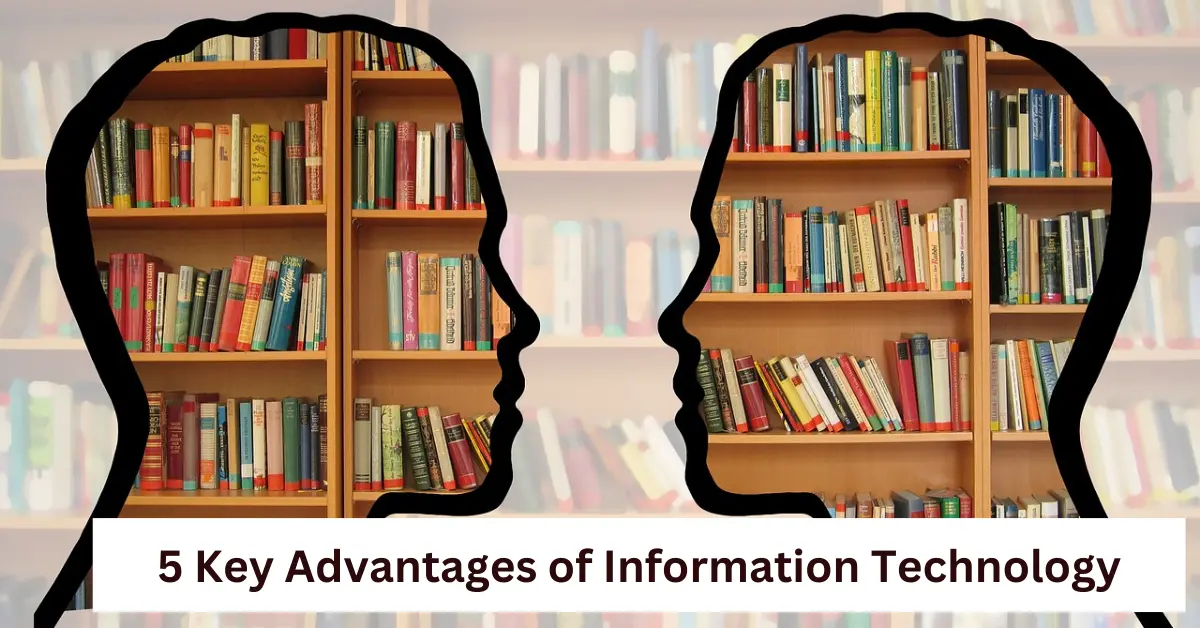5 Key Advantages of Information Technology for Business
Published: 12 Dec 2024
In the digital age, Information Technology (IT) is the backbone of modern society. From the way we communicate to how businesses operate, IT has revolutionized every aspect of our lives.
Its influence is undeniable, offering countless opportunities and benefits. This article delves into the top 5 advantages of Information Technology, exploring how it impacts individuals, businesses, and the word.

What is Information Technology?
At its core, Information Technology involves using computers, software, networks, and other digital tools to manage and process information. It is not just a tool—it’s a critical enabler that supports communication, automation, decision-making, and innovation.
Let’s explore the top 5 advantages IT brings to our lives.
Enhanced Communication
One of the most transformative benefits of IT is how it has revolutionized communication. In the past, connecting with someone miles away could take weeks. Now, with IT tools, you can communicate instantly, no matter where you are in the world. what is an information technology
How IT Enhances Communication:
Instant Messaging: Platforms like WhatsApp, Slack, and Microsoft Teams enable real-time text, voice, and video communication.
Video Conferencing: Tools like Zoom and Google Meet allow face-to-face communication without geographical limitations.
Email and Cloud-Based Collaboration: Email services and platforms like Google Workspace make it easier for teams to collaborate on projects in real-time.
Example:
Imagine running a business with team members spread across different countries. With IT tools, virtual meetings and shared workspaces ensure seamless collaboration.
Key Takeaway:
IT eliminates barriers, making communication faster, more efficient, and cost-effective.
Access to Information Anytime:
One of the most transformative benefits of Information Technology (IT) is the ability to access information anytime, anywhere. In the digital age, information is the most valuable resource, and IT ensures it is readily available at your fingertips. Whether for education, business, research, or personal growth, IT has revolutionized how we find and use information. 5 Uses of Information Technology
How IT Enables Universal Access to Information
The Internet: A Gateway to Knowledge
The internet, a cornerstone of IT, provides a vast repository of information on any topic imaginable. From academic articles and how-to guides to entertainment and news, the internet makes information universally accessible.
Cloud Technology for On-the-Go Access
Cloud computing has transformed the way information is stored and accessed. Unlike traditional storage methods, cloud technology allows users to store data remotely and retrieve it from any device.
Examples of Cloud Services:
Google Drive and Dropbox: Provide secure storage and easy file-sharing options.
OneDrive: Offers seamless integration with Microsoft Office for remote work.
Impact: Cloud technology ensures that important documents, presentations, and media files are always available, no matter where you are. What is IoT (Internet of Things)
Access to Information Anytime, Anywhere
The internet, powered by IT, has democratized access to information. Whether you’re a student researching for an assignment, a professional looking for industry updates, or simply curious about a topic, IT ensures you have what you need at your fingertips.

How IT Provides Information Access:
Search Engines: Tools like Google and Bing make finding information simple and fast.
Educational Platforms: Websites like Khan Academy and Coursera offer free or affordable courses to learners worldwide. it films 2017
Cloud Technology:
Services like Google Drive and Dropbox allow you to store and retrieve documents, photos, and files from anywhere.
Example:
During the pandemic, online learning platforms ensured students could continue their education remotely.
improve data management
Improved data Management refers to the systematic process of managing data to ensure its quality, security, accessibility, and usability throughout its lifecycle. It involves the collection, storage, organization, processing, analysis, and distribution of data in a way that maximizes its value and ensures it can be leveraged effectively for business or operational purposes.
Here are some key components of Improved Data Management in more detail:
Data Quality
Accuracy: Ensuring that data is correct and free from errors.
Consistency: Data should be consistent across different systems or platforms, avoiding discrepancies.
Completeness: Data should be comprehensive, with no missing or incomplete entries that could affect analyses or decision-making.
Timeliness: Data should be up-to-date and available when needed to make real-time or strategic decisions.
Validity: Data must adhere to predefined formats, rules, or constraints to be meaningful and usable.
Data Integration
Cross-system Data Unification: Improved data management ensures seamless integration across different systems and departments. This may involve pulling data from diverse sources, including legacy systems, databases, cloud services, and third-party applications.
Data Pipelines: Using automated data pipelines to aggregate and process data from various sources for analysis.
ETL (Extract, Transform, Load) These processes help in cleaning, transforming, and integrating data from multiple sources, ensuring that all data is accessible and usable for decision-making.
Data Security
Data Encryption Securing data during storage and transmission to prevent unauthorized access or breaches.
Access Controls: Implementing roles and permissions to control who has access to what data, ensuring that sensitive information is protected.
Backup and Recovery: Developing strategies to regularly back up data and recover it in case of system failures, ensuring data availability and minimizing loss.
Data Masking and Anonymization: Techniques that protect sensitive information by obfuscating or anonymizing personal identifiers and other confidential details.
Data Governance
Policies and Compliance: Establishing data management policies and ensuring compliance with regulatory standards (e.g., GDPR, HIPAA). This includes maintaining accurate records of data usage and access.
Data Stewardship: Designating responsible individuals or teams (data stewards) to oversee the management of data assets, ensuring adherence to governance policies.
Data Lineage: Understanding and documenting the lifecycle of data, from its origin to its final destination, to ensure its integrity and track any transformations or changes.
Data Accessibility and Availability
Data Sharing: Implementing secure data-sharing mechanisms across departments and external partners, ensuring data is readily accessible for analysis and reporting.
Cloud Storage and Data Lakes: Leveraging cloud-based solutions and data lakes to store vast amounts of structured and unstructured data, making it more accessible while maintaining security and scalability.
Data Cataloging: Creating a centralized, searchable data catalog or metadata repository that enables users to easily discover and access the right datasets.
Quiz Title: How Well Do You Know the Advantages of Information Technology?
Questions:
- What is one major benefit of Information Technology in business?
- a) Increased paper usage
- b) Faster communication and collaboration
- c) Higher operating costs
- d) More manual labor
- Which of the following is a key advantage of Information Technology in healthcare?
- a) Limited access to data
- b) Improved patient care and data management
- c) Longer hospital stays
- d) Reduced access to health resources
- How does Information Technology enhance business productivity?
- a) By eliminating the need for innovation
- b) By automating routine tasks and processes
- c) By increasing downtime
- d) By reducing communication
- Which of the following best describes IT’s role in data management?
- a) It makes data harder to organize
- b) It allows for faster and more secure data storage and retrieval
- c) It increases the chances of data loss
- d) It makes data storage less accessible
- Which is an example of cost reduction through Information Technology?
- a) Increased need for physical paperwork
- b) Digital marketing and online sales
- c) More physical store locations
- d) Increased reliance on manual labor
Answers:
- b) Faster communication and collaboration
- b) Improved patient care and data management
- b) By automating routine tasks and processes
- b) It allows for faster and more secure data storage and retrieval
- b) Digital marketing and online sales
Result:
- 5-4 Correct: IT Expert! You truly understand the advantages of information technology.
- 3 Correct: Great job! You know a lot about IT’s benefits, but there’s more to learn!
- 2 or fewer Correct: Keep exploring! There’s a lot more to discover about how IT improves our world.
Innovations in Healthcare
Innovations in Healthcare refer to new ideas, technologies, and processes that aim to improve the delivery, quality, accessibility, and affordability of healthcare services. These innovations are revolutionizing the way healthcare is practiced, making it more efficient, personalized, and patient-centered. Below are some key areas of innovation in healthcare, explained in more detail:
Telemedicine and Telehealth
Remote Consultations: Telemedicine allows patients to consult with healthcare providers remotely using video conferencing, phone calls, or messaging apps. This is especially important for people in rural or underserved areas who may not have easy access to healthcare facilities.
Chronic Disease Management: Telehealth tools enable healthcare providers to monitor patients with chronic conditions (e.g., diabetes, hypertension) remotely, adjusting treatments based on real-time data.
Mental Health Services: Online therapy and counseling services provide patients with access to mental health professionals without having to visit an office in person, expanding access to psychological support.
Artificial Intelligence (AI) and Machine Learning
Predictive Analytics: AI algorithms analyze large datasets to predict disease outbreaks, patient risks, and potential outcomes. For example, machine learning models can predict which patients are at higher risk for conditions like heart disease or sepsis, allowing for early intervention.
Diagnostic Tools: 5 Key Advantages of Information Technology for Business AI has been integrated into diagnostic tools to help detect diseases like cancer, heart conditions, and neurological disorders. For instance, AI systems can analyze medical images (e.g., X-rays, MRIs) with high accuracy, sometimes even outperforming human doctors in terms of speed and precision.
Personalized Medicine: AI can also help tailor treatments based on an individual’s genetic makeup and medical history, providing personalized healthcare that improves patient outcomes.
Wearable Technology
Health Monitoring Devices:
Wearables like fitness trackers, smartwatches, and biosensors continuously monitor health metrics such as heart rate, blood pressure, sleep patterns, and oxygen levels. This data can be sent to healthcare providers for real-time monitoring and early intervention.
Wearable ECG Monitors:
Devices like the Apple Watch or specialized wearables like the Zio Patch enable continuous monitoring of cardiac health, allowing patients with heart conditions to track their heart rhythms and alert doctors to any abnormalities.
Smart Prosthetics:
Advancements in wearable prosthetics include devices that offer real-time feedback and improved functionality, such as prosthetic limbs controlled by brain signals or pressure sensors that adapt to the user’s movements.
Conclusion:
Information Technology (IT) has become the backbone of modern business, driving efficiency, innovation, and growth. Its key advantages include enhanced communication, streamlined operations, improved data management, heightened security, and global reach. By leveraging IT effectively, businesses can remain competitive, adapt to changing markets, and deliver exceptional value to customers. Embracing IT is not just an option; it’s a strategic necessity for sustainable success in today’s digital age.
Proudly powered by WordPress






